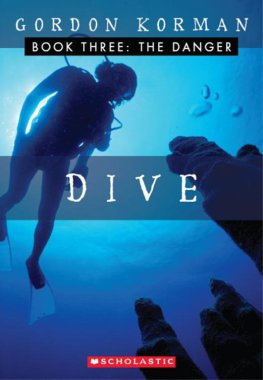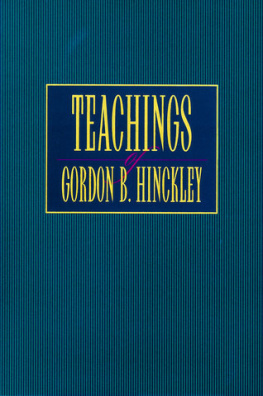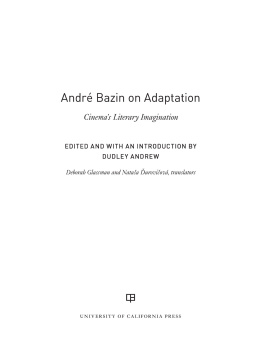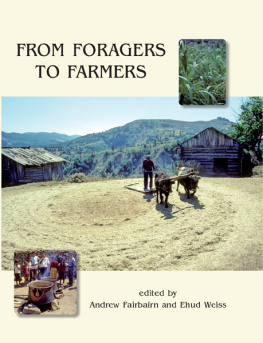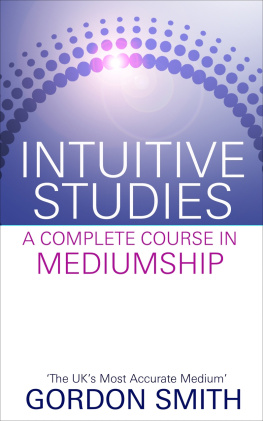Adaptation Theory
and Criticism
Adaptation Theory
and Criticism
Postmodern Literature and Cinema in the USA
GORDON E. SLETHAUG

Contents
S ince George Bluestones 1957 Novels into Film , Robert Richardsons 1969 Literature and Film , and the 1973 introduction of Literature/Film Quarterly that provided an important space for discussion of individual adaptations, historicizing and theorizing film adaptation and refuting fidelity studies has been an ongoing endeavor, giving way to a plethora of examinations. The development of adaptation theory, however, was off to an unexpectedly slow start.
Part of the reason adaptation theory did not succeed immediately after Bluestone and Richardson, as Timothy Corrigan suggests, is that during the 1970s and 1980s English studies and film studies moved in the direction of medium-specific, neo-formalist studies and toward ideological studies, neither particularly hospitable to adaptation studies (2007, 40). If new criticism and cultural studies left little space for literature-film comparisons, they did leave room for analysis of particular texts, a tendency that has endured with some success. Indeed, Christine Geraghty recently has made a strong neo-formalist case for looking at the particular ways in which adaptations make their own meanings (2008, 4) through setting, landscape, and costumes.
Another part of the reason that the study of adaptation was not entirely liberated from earlier fidelity studies can be attributed to logocentricism or a belief that words come first and that literature is better than film (Cartmell, Corrigan, & Whelehan 2008, 1). Significant in this belief is the appeal to the originary written work and also to authorial intention, so far as it can be apprehended (Leitch 2007, 3).
In addition, because in English departments adaptations are often discussed and ranked with reference to such mainstream figures as Shakespeare, Austen, Thackeray, Dickens, Wharton, and Hemingway, the study of adaptation often remains firmly linked to the primacy of canonical texts and writers. In short, because film adaptation was seen as a foster child in literature and film departments, because the literary often stood above the cinematic, and because the written word of canonical literary figures was frequently the gold standard by which the cinematic was judged, adaptation theory was given short shrift for a time after Bluestone and Richardson.
Even with those restraints, adaptation studies began to be incorporated within academia in the 1970s and critics increasingly argued against faithfulness of film to originating text. As Millicent Marcus notes,
If the most avid proponents of faithfulness expect a literal-minded transcription of the novel in film, more advanced thinkers, like biblical allegorists, distinguish between the letter and the spirit of the original, and, in an enlightened recognition of the unique discursive requirements of the two media, ask only that the adaptation be faithful to the spirit of its precursor text. (1993, 16)
Robert Stam adds to this argument, asking what faithfulness really means:
Should one be faithful to the physical descriptions of characters? Perhaps so, but what if the actor who happens to fit the description of Nabokovs Humbert also happens to be a mediocre actor? Or is one to be faithful to the authors intentions? But what might they be, and how are they to be inferred? And to what authorial instance is one to be faithful? To the biographical author? To the textual implied author? To the narrator? Or is the adapter-filmmaker to be true to the style of a work? To its narrative point of view? Or to its artistic devices? (2000, 5758)
Using a story and discourse distinctionthat the story has a code of narrativity while discourse is contextually and culturally defined and bound, many argue that the author and adapter both keep the story in mind, but that in the public forum the linguistic and cultural context is especially relevant to the film, thereby muting the story-film adaptation debate (Marcus 1993, 14).
Others have added to theory as well, seeing a broad spectrum of adaptations and inventing new categories of analysis. In 1975, Geoffrey Wagner distinguished between transposition, commentary, and analogy. In 1984, Dudley Andrew divided adaptation into borrowing, intersection, and fidelity of transformation (2000, 29); in 2003 Kamilla Elliot, arguing that film adaptation operates on the basis of interart analogy, offered six approaches to adaptation, including psychic, international, ventriloquist, decomposing, genetic, and trumping; in 2006 Linda Cahir referred to literal, traditional, and radical translations (instead of adaptations); and in 2007 Thomas Leitch provided a ten-stage taxonomy of hypertextual relations as they shade off to the intertextual (2007, 93126) that included celebration, adjustment, neoclassic imitation, revision, colonization, metacommentary or deconstruction, analogy, parody or pastiche, secondary-tertiary-and-quaternary imitation, and allusion.
All told, these categories are indicative not only of what Deborah Cartmell and Imelda Whelehan call the will to taxonomize (2007, 2), but especially the need to move away from the rigid faithfulness to see the new possibilities in adaptation. In other words, Platonic metaphysics was replaced not just by Aristotelian taxonomy but by a fluidity of approaches and relationships including readings, translations, transmutations, transformations, intersemiotic transpositions (Stam 2000, 62, 70), narrative transmutability (Ray 2000, 39), transferability (McFarlane 2007, 1920), and performativeness (Naremore Introduction 2000, 78) that would open the field in a healthy way.
Of late, adaptation theory has incorporated tropes of linguistic and semiotic analysis, post-structural and postmodern enquiry, textual reproduction, and cultural criticism to indicate that adaptations have value, validity, and integrity not dependent upon the originals and able to say interesting and unique things about language and culture. Andrew, Stam, Hutcheon, Leitch, and Cartmell and Whelehan note that the adaptation process is much more far ranging than was previously admitted with originals and adaptations consisting, among other things, of comic books, video games, role-playing games, and board games. Moreover, these critics note that views of the dialogic play of textuality and intertextuality, which Julia Kristeva, Roland Barthes, and Mikhail Bakhtin were among the first to theorize, have opened up a new discursive enquiry into adaptation theory (Ray 2000, 41).
This assessment of intertextuality in film now goes back several decades. Janet Staiger, referencing Barthes and Genette, finds that intertextuality is not simply
some relation between two texts, but rather a fundamental and unceasing spectatorial activity, the semiotic action of processing a filmic narrative by repeated referencing and referring to other texts. Intertextuality as understood from a poststructuralist perspective is a constant and irretrievable circulation of textuality, a returning to, a pointing toward, an aggressive attempt to seize other documentsthe results of this procedure of referencing other texts are also complicitly and irrevocably circular and ideological. For although the activity of intertextuality is neutral and without cessation, none of the discourses invoked are neutral nor is the real ever fixed, halted, and cured but only referred to, compulsively and repetitiously. (1989, 399)
Updating this view, Hutcheon, drawing on views of Jacques Derrida, finds intertextual play a central part of the spirit and mechanics of adaptation which she subdivides into the process of adaptation, the product generated, and the process of reception. In this way, Hutcheon joins Staiger, Leitch, McFarlane, Ray, Andrew, Cartmell and Whelehan, and Brooker who see adaptations in terms of intertextuality, repudiate the transcendent order of the traditional original/copy paradigm, and affirm the de-hierarchizing impulse, a desire to challenge the explicitly and implicitly negative cultural evaluation of things like postmodernism, parody, and now, adaptation, which are seen as secondary and inferior (Hutcheon 2006, xii).
Next page

